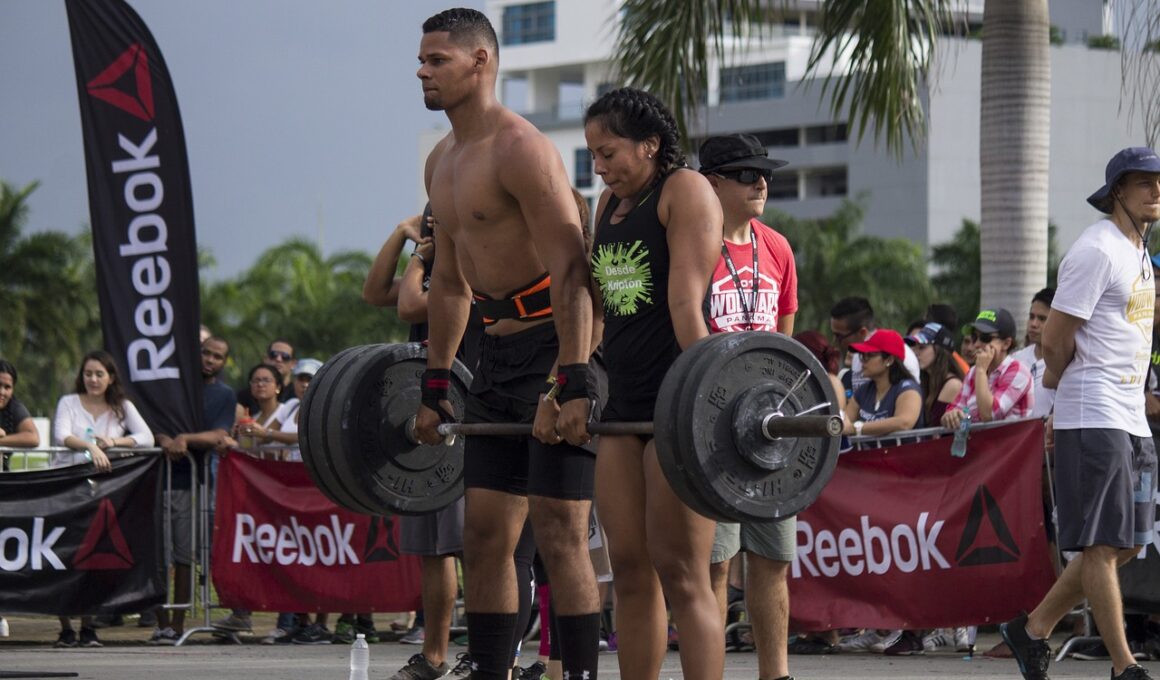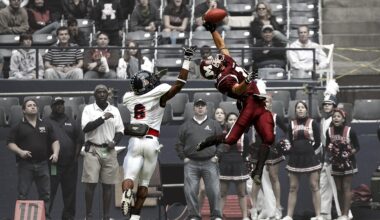Strengthening Your Core to Enhance CrossFit Olympic Lifting Performance
A strong core is essential for maximizing your performance in CrossFit Olympic lifting techniques. Whether you are snatching, cleaning, or jerking, stability comes first from the core. A robust core provides the necessary balance and transfer of power in lifts. It is comprised of multiple muscles including the abdominals, obliques, and lower back, which need to function cohesively. Additionally, engaging your core helps protect your spine from injury during heavy lifts. As you perform clean and snatch exercises, be mindful of your posture and alignment. It is advisable to maintain a neutral spine and keep the core engaged throughout the movement. Focus on breathing techniques as well; exhaling during the lift can help tighten the core further. Core strengthening exercises such as planks, Russian twists, and medicine ball throws should be incorporated into your training regimen. These exercises not only build muscle endurance but also enhance overall lifting efficiency. A strong core stabilizes your body during dynamic movements, allowing for better technique and consistency. Preventing common injuries rooted in poor core engagement is another benefit, helping you train more effectively and regularly.
Once you have established a solid foundation of core strength, consider exploring specific drills designed for Olympic lifting. Engage in movements that directly translate to the required stability in the lifts. Deadlifts, for instance, strengthen the posterior chain while reinforcing a strong hinge at the hips. To facilitate better technique, practice the clean pull, focusing on driving through the legs while maintaining core tension. Progressively increase the weight lifted to challenge your muscles, ensuring not to compromise form. Accessory lifts like the kettlebell swing and overhead squat also promote functional core strength. These exercises enhance your ability to stabilize under load, which is crucial for successful Olympic lifting. Incorporating dynamic core work with stability balls can add variety to your routine. Furthermore, don’t discount the importance of flexibility and mobility; they play a crucial role in allowing a full range of motion during lifts. Stretching your hip flexors and hamstrings will help maintain a proper lifting stance. Regularly incorporating mobility exercises can significantly improve your overall performance. Towards this effort, engage in dynamic warm-ups to prepare your body for intense lifting sessions effectively.
Incorporating Mobility and Flexibility Work
Mobility and flexibility are paramount when aiming to achieve optimal positions in Olympic lifts. Without proper range of motion, even the strongest core will fall short in execution. Developing flexibility in the lower body allows for proper squat depth and positioning during cleans and snatches. In particular, hip, ankle, and thoracic spine mobility are critical areas to address. Utilize dynamic stretching before workouts to prepare your muscles for lifting. Spend time performing hip openers such as the world’s greatest stretch or butterfly pulls. These movements serve to enhance both hip flexibility and thoracic extension. Foam rolling can also aid in releasing tight muscles, promoting better mobility. Incorporating yoga or specific mobility routines into your schedule can enhance joint flexibility, ultimately impacting your overall lifting performance. Additionally, consider working with mobility specialists or coaches who can provide personalized assessments. Their feedback becomes invaluable in fine-tuning your technique. Remember, the goal is not just strength but also fluidity in your movements. As flexibility and mobility improve, observe how it influences your lifting efficiency positively. Consistent effort in this area leads to breaking personal records more smoothly.
Nutrition plays a significant role in supporting your Olympic lifting and core strength objectives. Proper nutrition fuels your body for maximum performance, enabling you to recover and grow stronger. Prioritize a balanced diet rich in proteins, healthy fats, and carbohydrates. Proteins are vital for muscle recovery and growth, playing a crucial role in strengthening your core muscles. Including lean meats, fish, eggs, beans, and legumes will provide the necessary building blocks. Healthy fats, such as avocados and nuts, aid in maintaining optimal hormone levels while supporting overall health. Quality carbohydrates are needed to sustain energy levels during workouts. Consider incorporating complex carbs from whole grains, fruits, and vegetables into your meals. Additionally, hydration is key; adequate water intake ensures proper muscle function and recovery. Experiment with meal timing to find what best supports your performance. Pre-workout meals should be lighter, focusing on carbs, while post-workout meals should prioritize protein and recovery. Tracking your nutrition can offer insights into your energy levels and overall performance. Cultivating healthy eating habits alongside physical training ensures your body supports you in achieving your goals efficiently.
Implementing Recovery Strategies
Another critical aspect of enhancing your Olympic lifting performance lies in effective recovery strategies. Without proper recovery, even intense training sessions can lead to overtraining and increased injury risks. Emphasize the importance of rest days, allowing your muscles the necessary time to heal and rebuild. Post-lifting recovery methods should include cooling down and stretching, focusing on the muscles engaged during your workout. Light aerobic workouts or yoga can promote muscle recovery and flexibility, ensuring your body is prepared for the next training session. Consider integrating rest techniques such as ice baths or contrast showers, which may reduce muscle soreness. Additionally, prioritize sleep; restorative sleep allows your body to recover physically and mentally. Assess your sleep quality and duration; aim for at least seven to eight hours nightly. Nutrition plays a crucial role in recovery as discussed earlier, so remember to nourish your body adequately. Furthermore, listen to your body for signs of fatigue or pain; pushing through can lead to setbacks. Taking days off for recovery may feel counterproductive, but it is essential for long-term success in Olympic lifting.
Form and technique cannot be overstated when discussing Olympic lifting. The foundation of any successful lift begins with mastering perfect form, which is integral to safety, performance, and efficiency. Train under the supervision of qualified coaches or via instructional videos to refine your technique. Focusing on body alignment during lifting is critical; improper stances can lead to injuries. Ensure that your feet, knees, and shoulders align correctly throughout the lift. Practice with lower weights and perfect your technique before gradually increasing the load. Consider breaking down each movement into segments to better understand the mechanics involved. Use drills like pause cleans and snatch balances to emphasize technique under controlled conditions. Emphasizing the importance of explosive power, initiate the lift from a strong position and engage the core. Film your lifts to analyze your form and identify areas for improvement. Don’t hesitate to seek feedback from peers or trainers, as constructive criticism is invaluable. Always prioritize establishing solid technique rather than lifting heavier. With practice and discipline, mastering the intricacies of Olympic lifts will become second nature.
Staying Motivated and Engaged
Motivation is key when setting out to improve Olympic lifting performance and core strength. Lifters often face plateaus or obstacles that can derail their progress. Ensuring that you remain engaged in your training is essential for sustained improvement. Setting realistic and measurable goals can serve as motivation throughout your fitness journey. Establish short-term goals that focus on technique improvement, such as perfecting your clean or improving core engagement. Consider joining a supportive CrossFit community or finding a lifting buddy to train with regularly. Working alongside others can enhance accountability and provide a motivational boost. Incorporate variety into your workouts to keep things fresh; experiment with different lifting sequences or accessory movements. Challenge yourself by participating in local competitions or goal-oriented events. Tracking your lifts and progress can help visualize your accomplishments. Celebrate small victories to maintain enthusiasm and remind yourself of your progress. Continuously educate yourself about Olympic lifting techniques and upcoming trends in the sport. Understanding the science and methodology behind your training will deepen your passion, eventually leading to higher performance in Olympic lifting.
In conclusion, enhancing your CrossFit Olympic lifting performance significantly hinges on core strength, technical proficiency, and supportive recovery practices. Your core is your powerhouse; dedicating time and effort to strengthening it will yield substantial benefits in lifting stability and power transfer. Prioritize core-focused exercises, flexibility training, proper nutrition, and recovery to facilitate improvements. Recognize that the journey of bettering your lifting skills is evolutionary and not just transitional. Focusing on continuous learning and refining your techniques will create a substantial impact on your overall performance outcomes. Embrace the challenges and remain adaptable to overcome hurdles. Track your progress diligently and appreciate each transformation. Never underestimate the value of motivation; staying committed to your goals is the key to long-term success. Periodically challenging yourself with new objectives will keep your passion alive. Leveraging the support of your community can be a game-changer too, providing encouragement and sharing knowledge. Ultimately, enhancing Olympic lifting performance requires holistic attention. Implementing these strategies with patience and vigor will lead to significant advancements in your CrossFit journey. Remember, success may not always be linear, but it will undoubtedly yield rewarding results over time.


